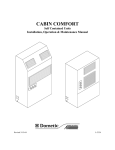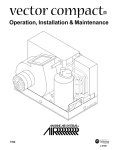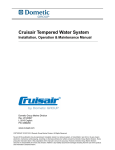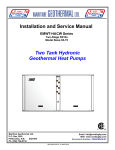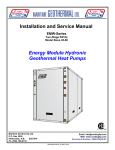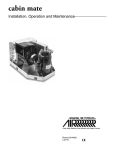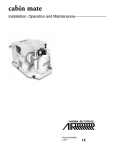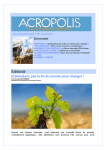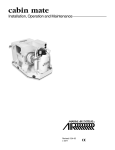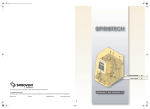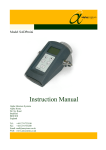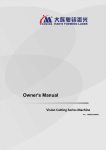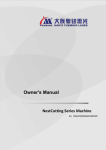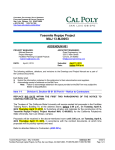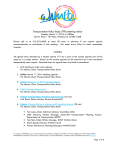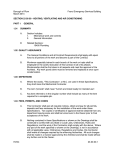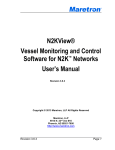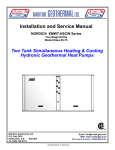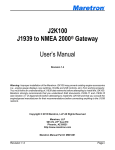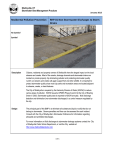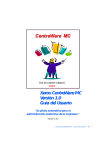Download for DDC Controls - Tropical Marine Air Conditioning
Transcript
mcw chiller ® Installation, Operation & Maintenance Manual for MCW Chillers Using the DDC – Digital Diagnostic Control 8/04 L-2164 PREFACE Congratulations on the purchase of your air conditioning chilled water system. No matter which of the following features was the reason you purchased this chilled water system, we are sure it will meet your needs and will give you many years of efficient and trouble free use. The chiller® series of modular chilled water systems are designed for boat applications starting at approximately 40 foot in length. They are available in capacities from 24,000 to 600,000 BTU’s and voltages of 208, 230, and 460 volt 60 hertz and 220 or 380 volt 50 hertz, single or three phase. These systems can provide ideal solutions for problems of space requirements, amperage consumption and weight for both new boat and retrofit applications and are designed for marine applications incorporating the following features: • • • • • • • • Spiral fluted cupronickel condenser coil for maximum heat transfer Compressors offering reduced amperage draw, up to 25% less than conventional units Stainless steel brazed plate chilled water heat exchangers Remote mountable electrical box Pre-charged and pre-wired systems for easy field connections Charge Guard® protection to insure refrigerant integrity during handling and installation Light weight aluminum construction for corrosion protection Control circuit provides multiple fail-safes for system protection This manual is intended to provide the information necessary to ensure proper operation and maintenance of the chiller® series units. Misunderstood operating procedures can result in unsatisfactory performance and/or premature failure of these units, so before proceeding please read this manual completely. The chiller® series units are covered under the existing Marine Air Systems warranty policy contained in this manual. In the interest of product improvement, Marine Air Systems’ specifications and design are subject to change without prior notice. MARINE AIR SYSTEMS Marine Air Systems (MAS) is a division of Dometic Corporation. Dometic is a recognized leader in the design and manufacture of high-performance comfort control systems, refrigeration products and battery charging products for demanding environments, including commercial and recreational marine craft, vehicles and other applications. We offer an unparalleled scope of products, dealer networks, applications support, engineering resources and production capabilities throughout the world. Our team has many years of experience in the design, manufacture, application and support of our products. Our practical experience and design capability allows our application engineers and sales representatives to offer optimum solutions for your environmental control requirements. Product lines also include well-known Cruisair, Grunert, and Sentry. Original print date: 4/98 Revised: 12/98, 10/99, 4/00, 8/01, 8/04 i TABLE OF CONTENTS How It Works............................................................................................................................................. 1 Safety Considerations ............................................................................................................................. 1-2 Definition of Terms Used in this Manual ............................................................................................... 2-4 Electrical Grounding and Bonding ............................................................................................................ 5 3 Phase Notice............................................................................................................................................ 5 Condensing Unit and Electric Box ............................................................................................................ 6 Air Handlers............................................................................................................................................... 6 Mounting Digital Air Handler Controls ........................................................................................... 6-7 Ducting ............................................................................................................................................. 7-8 Supply and Return Air Grilles............................................................................................................. 8 Sizing of Ducting and Grilles for Draw Thru & Flex Duct Air Handlers........................................... 8 Draw Thru & Flex Duct Air Handlers................................................................................................. 9 Blow Thru Air Handlers.................................................................................................................... 10 Slim Line Air Handlers ..................................................................................................................... 11 Condensate Drains............................................................................................................................. 12 Seawater Pump......................................................................................................................................... 12 Seawater Plumbing ............................................................................................................................. 12-13 Seawater & Chilled Water Manifold Sizes.............................................................................................. 14 Chilled Water Circulation Circuit............................................................................................................ 14 Recommended Pipe or Hose Size vs. System Capacity .................................................................... 14 Circulation Circuit Pressure .............................................................................................................. 14 Chilled Water Pump .......................................................................................................................... 15 Suggested Piping to Air Handlers ..................................................................................................... 15 Fresh Water Fill System .................................................................................................................... 15 Insulation ........................................................................................................................................... 16 Piping Installation....................................................................................................................... 16&19 Typical Chilled Water System Installation Diagram.................................................................... 17-18 Miscellaneous Optional Components................................................................................................ 19 Flushing the Circulation Circuit ........................................................................................................ 20 Filling & Purging the Circulation Circuit.......................................................................................... 20 Generic Wiring Diagram for Line Voltage MCW System ................................................................. 21-22 Individual Unit Wiring Diagrams (see chiller electric box for unit specific wiring diagram) ........... 23-28 DDC – Digital Diagnostic Controller ...................................................................................................... 29 DDC Specifications ........................................................................................................................... 30 DDC Programmable Parameters........................................................................................................ 30 Fault Display Codes (see also Trouble-Shooting Guidelines) .......................................................... 31 Using the Bimini Jumpers for Trouble-Shooting .............................................................................. 31 Sequencing the Compressors............................................................................................................. 31 Start-Up of the System............................................................................................................................. 32 Maintenance............................................................................................................................................. 32 Routine Maintenance.................................................................................................................... 32-33 Extended Maintenance ................................................................................................................. 33-34 Winterization and the Use of Glycol ................................................................................................. 35 De-Winterizing .................................................................................................................................. 36 Seawater Condenser Coil Cleaning Procedure.................................................................................. 36 Trouble Shooting Guidelines .............................................................................................................. 37-38 Manufacturer’s Limited Warranty Agreement ........................................................................................ 39 System Specific Settings.......................................................................................................................... 40 Maintenance Record ................................................................................................................................ 41 Distributor Listing.................................................................................................................................... 42 ii HOW IT WORKS Your chilled water air conditioning system consists of the chiller, air handlers installed throughout the vessel, fresh water piping connecting the chiller to the air handlers, and the seawater system. The chiller consists of three major components: the compressor, the “tube in tube” condenser coil and the evaporator (or heat exchanger). The chiller is charged with a refrigerant that circulates throughout these components. The air handlers consist of two major components: the blower and coil. Fresh water circulates through the piping from the chiller to each air handler and back. In cooling mode, warm cabin air is drawn (or blown) across the air handler coil by the blower. Heat is removed from the air as it passes across the coil. The cooled air is then blown back into the cabin. The heat from the cabin air is transferred to the fresh water circulating through the coil. The warmed water is pumped back to the chiller. The water is circulated through the chiller evaporator where the heat is transferred to the refrigerant in the evaporator coil, thus cooling the “chilled” water. The “heated” refrigerant gas is returned to the compressor, compressed, and then circulated through the outer tube in the chiller condenser coil. Seawater is circulating through the inner tube of the condenser coil via the seawater system. The heat is transferred from the refrigerant to the seawater and pumped overboard taking the original cabin air heat with it. The chilled water (not seawater) is then pumped back through the piping to the air handlers in a continuous loop as the cycle repeats. If the vessel is heated, it is either by reverse cycle or electric heat. Each method pumps warm water from the chiller to the air handlers. For reverse cycle heating, the chiller refrigerant flows in the opposite direction through a reversing valve, thus adding heat to the fresh water loop, instead of removing it as in the cooling mode. Electric heat systems use a heater barrel to warm the fresh water. Some systems also use “chill chasers” which are electric heating coils built into the air handlers that warm the air directly. SAFETY CONSIDERATIONS Installation and servicing of this system can be hazardous due to system pressure and electrical components. Only trained and certified service personnel should install, repair, or service equipment. When working on this equipment, always observe precautions described in the literature, tags, and labels attached to the unit. Follow all safety codes. Wear safety glasses and work gloves and place a fire extinguisher close to the work area. Never install your air handlers in the bilge or engine room areas. Insure that the selected location is sealed from direct access to bilge and/or engine room vapors. Do not terminate condensate drain line within four (4) feet of any outlet of engine or generator exhaust systems, nor in a compartment housing an engine or generator, nor in a bilge, unless the drain is connected properly to a sealed condensate or shower sump pump. Danger! Electrical shock hazard. Disconnect voltage at main panel or power source before opening any cover. Failure to comply may result in injury or death. Warning! To minimize the hazard of electrical shock and personal injury, this component must be effectively grounded. Refer to installation guidelines for further information. (Continued) 1 Notice: This component is charged with a HYDROCHLOROFLUOROCARBON (HCFC) refrigerant R22. Effective July 1, 1992 it shall be unlawful for any person to knowingly vent or otherwise knowingly release any class I (CFC) or class II (HCFC) substance as a refrigerant in a manner which permits such substance to enter the atmosphere per the clean air act of 1990. Public law 101-549 title IV section 608-C. Failure to comply may result in severe penalties, including fines and imprisonment. DEFINITION OF TERMS USED IN THIS MANUAL AIR HANDLER: The fan coil unit that circulates air into a specific area for heating or cooling. Three types of air handlers are available: Draw Thru & Flex Duct - Air handlers with the fan positioned to draw air from the cabin across the air handler coil and deliver the conditioned air through duct work back into the cabin. Blow Thru - An air handler with the fan positioned to push or blow cabin air across the air handler coil directly into the cabin. No duct work is used on this type of air handler. Slim Line - A modular blow thru air handler with interchangeable panels for alternate supply and return air locations. Duct work may be used on this type of air handler; however, it must be a short plenum with the same size as the supply air opening in the unit to a same sized grille. BLEEDER PORTS: Capped ports connected to 1/4” flexible tubing located on the air handlers for purging air from the chilled water circulation system. BONDING: In the vessel’s electrical system, any metal that might come into contact with salt water is connected to the bonding circuit to help alleviate the effects of electrolysis (follow ABYC standards). BTU: (British Thermal Unit) A common term used to define and measure capacity or refrigeration effect. CFM: Abbreviation for “cubic feet per minute”, a term used to specify the volume of airflow through the air handlers and ducting. CHILL CHASER: An auxiliary electric heater located in the air handler. CHILLED WATER CIRCULATION CIRCUIT: This is supply and return piping from the chiller to the air handlers. The supply piping carries chilled water (in cool mode) from the chiller to the air handlers. Return piping carries warmed water (in cool mode) from the air handlers back to the chiller. The supply and return piping form a continuous closed loop. CHILLED WATER CIRCULATION PUMP: A centrifugal pump used to circulate the fresh water between the chiller and the air handlers for heat transfer. Since this pump is located in a “closed loop” system, it does not need to be installed below the water line of the vessel. Whereas the seawater pump does need to be installed below the water line. CIRCUIT BREAKER: An electrical device which provides high current and short circuit protection for the compressor, air handlers and pumps used in the chilled water system. HACR (heating, air conditioning & refrigeration) type circuit breakers are recommended for the ship’s panel. HACR circuit breakers have a long delay to compensate for the electrical surge associated with compressor. 2 COMPRESSOR: An electrical motor/pump that draws cool, low pressure refrigerant gas and compresses the gas into a hot, high pressure gas. COMPRESSOR OVERLOAD: An electrical device used to protect the compressor from excessive heat or current draw. CONDENSATE DRAIN PAN: The pan directly under the air handler’s coil for removal of the “condensed” moisture taken out of the cabin air. Two drain spud attachments are provided for connection to drain hoses for proper removal of the water to a sump. There is also a condensate drain pan located under each chiller and the chilled water pump. CONDENSER: The heat exchanger through which heat is transferred between the refrigerant in the chiller and the seawater flowing through the coils and manifold. DDC: Digital Diagnostic Controller circuit board mounted in the electric box monitors and protects the system through the use of an aquastat, timer, freeze stat, high limit switch and high & low pressure switches, all programmed to read out on a LED panel for immediate diagnosis. ELECTRIC HEAT: Electric resistance heaters are used as a chill chaser in the air handlers to warm the air, or in the chiller heater barrels to warm the circulating water in heat mode. EXPANSION TANK: A container housing a diaphragm (20 psig) to cushion against any water hammer in the circulation system piping. It also provides for expansion of the water volume as the water is heated. FAN SPEED CONTROL: An “on/off” switch that also regulates the amount of voltage supplied to the fan motor, thus controlling the speed at which the motor turns. FLOW SWITCH: A control device located on the chilled water supply side of each of the brazed plate heat exchangers that prevents the system from operating until water flow has been established, and turns the system off if the water flow is insufficient. FREEZE STAT: A low temperature thermostat used as a control device to sense chilled water temperatures and shut the entire condensing unit off when supply water temperatures in the circulation piping system reach 38°F. This prevents the possibility of rupturing the chilled water evaporator coil, as well as any other piping in the system, due to the water freezing. FRESH WATER FILL SYSTEM: Components installed on the return line to the chiller for filling the circulation circuit piping system. GPM: Abbreviation for “gallons per minute”, a term used to specify the amount of water flow through the chilled water or seawater system. HIGH LIMIT SWITCH: A high temperature thermostat used as a safety device to shut down the condensing unit when the water temperature in the circulation piping circuit reaches 120ºF. This prevents the possibility of damaging any PVC piping or any other components due to the water getting too hot. 3 HIGH/LOW PRESSURE SWITCHES: Electrical control devices operated by high and low side system refrigerant pressures respectively. If pressure is too high (425psig) or too low (35psig) the appropriate switch automatically opens the electrical circuit and shuts down the respective compressor. These switches reset automatically. MOTORIZED WATER VALVE: An electrically operated 3-way water regulating valve on an individual air handler controlled by the thermostat. This valve provides water flow through the air handler when opened, and bypasses water flow from the supply side to the return side when closed. PUMP RELAY PANEL (PRP): Used with more than one chiller, the PRP is a circuit board module wired between the chillers and the chilled water or seawater pump (one PRP for each pump). When any of the chillers is turned on to heat or cool both PRPs are energized and switch each pump on. Each PRP should have its own circuit breaker sized for the pump, but not to exceed 20 amps. REVERSING VALVE: (on reverse cycle units only) An electromagnetically controlled valve that reverses the flow of refrigerant between the condenser and evaporator of the chilled water condensing unit, thereby permitting heat to be extracted from the cabin in the cooling mode and added into the cabin in the heating mode. RUN CAPACITOR: An electrical storage device used to reduce amperage to some electric motors for more efficient operation. SEAWATER PUMP: A pump and motor combination that provides a continuous water flow through the condenser coil(s). The seawater pump must be installed below the water line for proper operation. SEAWATER STRAINER: A housing containing a screen made of metal or nylon to filter out debris drawn into the seawater circuit that could foul up the seawater pump or piping. The strainer must located between the thru hull inlet and seawater pump. START CAPACITOR: An electrical component that assists the compressor by releasing stored current during initial start up. START RELAY: An electrical device that controls the duration of voltage supplied from the start capacitor to the compressor on start up. THERMOSTAT: An adjustable control device that senses room temperature, via an air thermistor or sensor, and operates the motorized valve (if installed) on an air handler for water flow. THERMOSTATIC EXPANSION VALVE (TXV): A metering device used to convert high pressure liquid refrigerant to low pressure liquid refrigerant. THRU HULL FITTING: There are two different thru hull fittings used in the seawater circuit. The speed scoop strainer inlet fitting is mounted below the water and serves as the inlet for the seawater circuit. The discharge thru hull fitting is mounted above the water line and serves as the outlet for the seawater circuit. TON: In refrigeration/air conditioning, a ton is the amount of heat absorbed in melting a ton (2000 lbs) of ice over a 24-hour period. The ton of refrigeration is equal to 288,000 Btu in 24 hours. Divide 288,000 by 24 and get 12,000 Btu per hour. Therefore, one ton of refrigeration = 12,000 Btu/hr. 4 ELECTRICAL GROUNDING AND BONDING NOTE: Field wiring must comply with ABYC electrical codes. Power to the unit must be within the operating voltage range indicated on the data plate in the electric box. Properly sized HACR circuit breakers must be installed for branch circuit protection. See data plate for maximum fuse/circuit breaker size (mfs) and minimum circuit ampacity (mca). All chillers are supplied with a terminal strip mounted inside the electrical box. The electrical supply, ground wires, and pump circuits are all connected at this terminal strip. All units must be effectively grounded to minimize the hazard of electric shock and personal injury. The following are to be observed: 1. AC (alternating current) grounding (green wire) must be provided with the AC power conductors and connected to the ground terminal (marked “GRND”) at the AC power input terminal block of the unit(s), per ABYC standard E-8, or equivalent. 2. Connections between the vessel’s AC system grounding conductor (green wire) and the vessel’s DC (Direct Current) negative or bonding system should be made as part of the vessel’s wiring, per ABYC standard E-9, or equivalent. 3. When servicing or replacing existing equipment that contains a chassis-mounted “ground” stud, the service person or installer must check the vessel’s wiring for the existence of the connection required in item 2 above. ABYC standards are available from: American Boat and Yacht Council 3069 Solomon’s Island Rd. Edgewater, MD 21036 Telephone: (410) 956-1050 The condenser manifold comes equipped with a tab for wiring to the ship’s bonding system. The chiller must be connected to the ship’s bonding system to prevent corrosion due to stray electrical current or voltage. All pumps, metallic valves and fittings in the seawater circuit that are isolated from the unit by PVC or rubber hoses must be individually bonded to the vessels bonding system also. This will help eliminate any possibility of corrosion due to stray current or voltage. FAILURE TO PROPERLY GROUND AND BOND THE SYSTEM WILL VOID WARRANTY! 3 PHASE NOTICE For all three phase chillers (power source is either 208-230VAC/3∅or 380-460VAC/3∅), it is extremely important to insure that wiring and phase sequencing of the three phase power source is correct. Marine wiring standards call for power source phases L1, L2, and L3 to be color-coded BLACK, WHITE, and RED, respectively. These must be connected to the unit with the proper sequence. Otherwise, it will not operate properly. If the wiring sequence is incorrect, the unit’s compressor (Scroll type only) and pump (if applicable) will run in the reverse direction at a significantly increased noise level. Reverse compressor operation will result in increased suction pressure and reduced head pressure. No cooling will be produced. If the circulating pump runs in the reverse direction, the closed water loop will not achieve high enough operating pressures and air can not be eliminated from the system. If the seawater pump runs in the reverse direction, it will not deliver cooling water to the condenser. The electric heat may work properly, but reverse cycle heating will not. 5 CONDENSING UNIT AND ELECTRIC BOX The chilled water condensing units are designed to be installed below deck either in the engine room, machinery compartment, lazarette, or similar type area. They are unaffected by vibration, moisture or ambient temperatures up to 140°F (60°C). These units must be well secured on a sturdy, level surface with the two mounting brackets provided. The MCW Chiller must be installed so that it is accessible for service when required. Multi-stage chillers must have at least 12" of free space on the side for plumbing to the manifolds. The condensing unit is hermetically sealed and requires no ventilation for proper operation. Normal engine room temperatures will not affect operation of the condensing unit. The electric box can either remain mounted on the chiller, as shipped from the factory, or remote mounted. Single phase units have position sensitive start relays in the electric box. If the electric box is to be remote mounted, ensure that the start relay is in the up position. The start relay bracket inside the electric box may be rotated to accommodate a vertical mounting position. Three phase chillers have electric boxes that can be remote mounted either vertically or horizontally. AIR HANDLERS Air handlers are designed in three types of configurations - Draw Thru & Flex Duct, Blow Thru and Slim Line - to allow for flexibility in any application. All types must be fastened securely and level for proper operation and condensation removal. All air handlers must have an unrestricted return air stream. VERY IMPORTANT: Never install air handler in bilge or engine room areas. Insure that the selected location is sealed from direct access to bilge and/or engine room vapors. Do not terminate condensate drain lines within three (3) feet of any outlet of engine or generator exhaust systems, nor in a compartment housing an engine or generator, nor in a bilge (vapors can travel up the drain line), unless the drain is connected properly to a sealed condensate or shower sump pump. Failure to comply may allow bilge or engine room vapors to mix with the air conditioners return air and contaminate living areas. For installations on sailboats that heel over 15!, position air handlers so that the condensate pans drain port and starboard and use both drains teed together (see “Condensate Drains” section of this manual). MOUNTING DIGITAL AIR HANDLER CONTROLS Before mounting the digital display panel touch pad consider the location. The air sensor built into the display panel will provide excellent room air temperature sensing given a proper installation. The display panel should be mounted on an inside wall, slightly higher than mid-height of the cabin, in a location with freely circulating air where it can best sense average temperature. Do not mount the display in the supply air stream. Do not mount the display in direct sunlight, near any heat producing appliances or in a bulkhead where temperatures radiating from behind the panel may effect performance. Do not mount the display above or below a supply or return air grille. Do not mount the display behind a door, in a corner, under a stairwell or any place where there is no freely circulating air. Mount the display within display cable length (custom lengths available) of the a/c unit. Plug the display cable (8-pin connector) into the circuit board in the electric box and into the back of the display panel. Secure the display panel to a bulkhead with the adhesive strips provided. Clean the mounting surface with isopropyl alcohol only prior to placement (test alcohol on hidden portion of surface first). If the adhesive strips cannot be used directly on the bulkhead then use a plastic bulkhead adapter. The bulkhead adapter (sold separately) is mounted to the bulkhead with screws and the display panel is secured to the adapter with adhesive strips. Do not use a screw gun and do not over-tighten screws when mounting adapter. 6 If a proper location for room temperature sensing cannot be found for the display, an optional remote air sensor may be used. Mount the remote air sensor in the return air stream behind the return air grille/opening and plug its cable (6-pin connector) into the circuit board. Installing the remote air sensor will override the face plate sensor. An optional outside air temperature (O.A.T.) sensor and 6pin cable may also be used (only if the remote air sensor is not used). Mount the sensor outside but not in direct sunlight. Secure all cables but do not staple when mounting. See air handler control manual for water sensor mounting instructions. DUCTING Good air flow is critical for the performance of the entire system. It is highly dependent on the quality of the ducting installation. The ducting should be run as straight, smooth and taut as possible minimizing the number of 90 degree bends (two tight 90 degree bends can reduce airflow by 25%). The following table shows minimum duct diameters and their corresponding return and supply air grille areas in square inches. If a transition box is used, the total area of supply air ducts going out of the box should equal the area of the supply duct feeding the box. To calculate the square inch area of a round duct: divide the diameter by two to get the radius (r), multiply the radius by itself (r²), and multiply that number by 3.1416 (π). The following is a summary of proper ducting connections: 1. Pull back the fiberglass insulation exposing the inner mylar duct hose. 2. Slide the mylar duct hose around the mount ring until it bottoms out. 3. Screw 3 or 4 stainless steel sheet metal screws through the duct hose into the mount ring. Make sure to catch the wire in the duct hose with the heads of the screws. Do not use band clamps, the mount rings are tapered and the hose will slide off. 4. Wrap duct tape around the ducting and ring joint to prevent any air leaks. 5. Pull the insulation back up over the mylar to the ring and secure with tape. All ducting should: • Be appropriately sized for each application. • Run as smoothly and taut as possible. • Have as few bends or loops as possible. • Be securely fastened to prevent sagging during boat operation. • Have all excess ducting lengths trimmed off. • Not be flattened or kinked. • Be insulated when located in high heat load areas (hull side, mechanical compartments, etc.). The design of a proper supply ducting system in a boat begins with the outlet from the blower. The blower ring sizes used by MAS are designed to keep the air velocity and frictional pressure drop relatively low on the supply air side. Reducing the blower ring size will create higher air velocities. Higher air velocities will increase pressure drop and increase air flow noise. Increased pressure drop will reduce the overall air flow (CFM) and the heating or cooling capacity of the unit (BTU/hr). In order to keep the air to an acceptable velocity a ducting system should have the same cross sectional area as the blower ring. The following table shows the cross sectional area needed for each size unit as well as the size of the duct ring supplied on the unit. Several circumstances may be encountered where a larger duct size may be needed to achieve the desired air flow for a particular unit. These include excessively long duct runs (greater than twenty feet), large numbers of bends in the duct runs (greater than 3-90º bends), or a transition box located at the outlet of the blower. In each of these cases a duct size one inch larger than that shown in the following table should be used. 7 MAS recommends that ducting not be used on the return air side of a unit. However, if the unit must be return air ducted, it is recommended that the return air duct size be at least one inch larger in diameter than the recommended supply air duct size. The recommended minimum duct length for a draw thru type air handler is five feet (1.52m). This length prevents motor noise or vane tip noise on the blower wheel from being audible in the cabin area. The maximum duct length of twenty feet (6.04m) should not be exceeded. These longer duct runs can prevent proper air flow delivery, causing poor operation and performance. When using ducting transition boxes, the total outlet area should be at least equal to the inlet area. Built-in air plenums should be constructed to deliver proper air flow and minimize air noise. Plenums should be fully pressurized by the air delivery through the duct work and incorporate diffusers when necessary to create an even flow across the entire surface of the supply grille or outlet. The cross sectional area of the plenum should be equal to, or slightly bigger than, the supply duct. Undersized plenums create air turbulence and generally cause “noisy” air delivery. Oversized plenums do not pressurize sufficiently and cause poor or no air flow. All air plenums must be thoroughly sealed to prevent air leakage. Plenums constructed of conductive materials must be insulated properly to prevent condensation and possible water damage. Wood is a conductive material and should be sealed to prevent delamination, and insulated where necessary. SUPPLY & RETURN AIR GRILLES The return air grille should be placed as close as possible to the air handler to maintain direct uninterrupted airflow to the coil. It should also be mounted as low as possible. The return air grille should not be located in such a way that the supply air blows directly into it. This will cause “short cycling” which results in poor performance and inadequate air conditioning. All return air grilles must have a filter attached to prevent dust or particle build up in the coil. If return air grilles are not used (i.e., louvered doors, hidden cut outs, etc.) a filter should be attached to the air handler making sure that there is enough clearance for access to the filter for cleaning. The supply air grille should be mounted as high as possible in the cabin to ensure proper air flow. This application permits air flow across the ceiling of the cabin and causes natural convection currents with the cool supply air falling, and forcing the warm air through the return air stream or up to the ceiling to mix with the cooler air being distributed. Failure to deliver the supply air high can result in stratification of the air in a cabin, causing cooler temperatures near the floor and warmer temperatures near the ceiling. SIZING OF DUCTING AND GRILLES FOR DRAW THRU & FLEX DUCT AIR HANDLERS BTU/HR 4,000 6,000 9,000 12,000 16,000 18,000 24,000 Duct Diameter Duct Area Return Air Grille Supply Air Grille 4" dia 5" dia 5" dia 6" dia 7" dia 7" dia 8" dia 12.6 sq in 19.6 sq in 19.6 sq in 28.3 sq in 38.5 sq in 38.5 sq in 50.3 sq in 49 sq in 70 sq in 98 sq in 140 sq in 168 sq in 200 sq in 280 sq in 24 sq in 35 sq in 50 sq in 70 sq in 84 sq in 100 sq in 140 sq in 8 DRAW THRU & FLEX DUCT AIR HANDLERS These units are ductable air handlers with rotatable blower assemblies, providing diverse arrangements for supplying air to one or more cabins. They are designed to be installed low in a cabin area, under seats or berths, or in the bottom of lockers to maintain a return air stream close to floor level. Fastening the air handlers is accomplished through the mounting brackets and screws provided. The blower assembly should be rotated, if necessary, to provide the most direct ducting run possible. 9 BLOW THRU AIR HANDLERS These units are nonductable air handlers designed to be installed high in a cabin area: at the top of lockers, bulkhead corners or overhead compartments. They can be fastened securely using the four mounting grommets located in the upper four corners of the mounting plate. As no duct work is used, blow thru air handlers must be able to deliver air directly into cabin areas. They must be located against the inside of a bulkhead or partition common to the cabin to be conditioned. The supply air grille must be at least equal in surface area and dimensions to the coil. If the air handler cannot be flush mounted against the bulkhead or partition, a plenum chamber can be attached between the face of the coil and the inside of the partition. This plenum must be equal or slightly larger than the coil surface, sealed completely, and be a short, straight run. Due to their design, the blow thru air handlers cannot be connected to excessively long plenums, multi-directional plenums, or any duct work. The return air to a blow thru air handler is provided through a properly sized grille (at least equal to the size of the coil) located underneath, alongside, or behind the air handler. While this return air grille is located higher in the cabin and close to the air handler than a typical draw thru application, proper air circulation is still achieved. 10 SLIM LINE AIR HANDLERS Slim line air handlers are used in limited space situations. They are similar in application to the blow thru air handlers; however, slim lines can be mounted low in side panels and narrow bulkhead spaces. Currently, the slim line is constructed in two modules, the blower and the coil. The two modules can be configured horizontally or vertically. The horizontal configuration is used for overhead mounting and the vertical configuration is used for mounting behind bulkheads and panels. The return air grille must be the same size as on the unit. Slim line units can be ducted with the use of plenums. Follow the same guidelines for the blow thru units for plenum construction. 11 CONDENSATE DRAINS All units come with condensate drains. Under adverse climate conditions (for example, high humidity) condensate water could be produced at a rate of approximately one gallon per hour. With this in mind, it is important to route condensate drains properly utilizing all standard practices for securing hoses and mounting thru-hull fittings. After the condensate installation is complete, test the installation by pouring a quart of water into the pan and checking for flow. For installation of the condensate drain: • Attach a 5/8" I.D. reinforced hose to the hose barb drain spud with a hose clamp and tighten. • Install the condensate drain downhill from the unit and aft to a proper drainage area. • IMPORTANT NOTE: Do not terminate any condensate drain within three (3) feet of the outlet of engine or generator exhaust systems, nor in a compartment housing an engine or generator, nor in a bilge, unless the drain is connected properly to a sealed condensate or shower sump pump. Fumes and vapors can travel up the condensate line and contaminate the supply air to living quarters. • The drain lines should be installed as short and direct as possible with a continuous downhill pitch, free of loops, kinks, or upward bends. • For installations on sailboats that heel over 15!, position air handlers so that the condensate pans drain port and starboard and use both drains teed together. • If dual drain fittings are used they may be connected to a single condensation drain line if a minimum 2" (5.1cm) drop exists from the base pan drains to the connection fittings. SEAWATER PUMP The chillers condensing units are water-cooled and require a properly sized seawater pump for optimum operation. The seawater pumps are sized according to the BTU capacity of the chilled water unit. The seawater pump must be installed so that it is always at least one foot below the water line regardless of which tack the vessel is on. If the capacity of your air conditioning system is greater than or equal to 24,000 BTU/hr, the seawater pump is most likely air cooled and will need occasional oiling. See manufacturer’s labeling on the pump for maintenance instructions. • IMPORTANT: Each pump relay panel (PRP) must have a dedicated circuit breaker sized for the pump but not to exceed 20 amps maximum. • IMPORTANT: Pumps greater than 3/4 horsepower (HP) must be connected through a pump relay panel and not the DDC. This is true even for single stage units because the DDC control relay is not designed to handle the amp load of a larger pump. • Three phase pumps must be equipped with an overload. SEAWATER PLUMBING WARNING! Seawater cooling system pressure should not exceed 30psig. Seawater temperature will directly affect the chiller’s efficiency. This chiller can effectively cool your boat in water temperatures up to 90ºF and heat (if reverse cycle option is installed) in water as low as 40ºF. Use electric heat (if installed) in seawater temperatures below 40ºF. Install the seawater speed scoop intake as far below the water line and as close to the keel as possible in any application, but especially on a sailboat, to keep the intake in the water when the boat heels over so that air does not get into the system. A speed scoop should be utilized to insure positive water flow while the vessel is underway. The speed scoop must be installed facing forward and not be shared with any other pump. A full flow bronze sea cock (ball valve), connected directly to 12 the speed scoop intake, must be used to be able to disrupt the incoming water to the sea strainer and pump should the need arise. The thru-hull, strainer, and hoses should be equal in size to the pump inlet. Bed the speed scoop and thru hull with a marine type sealant. Since the seawater pump is centrifugal and not self-priming, it must be mounted so that it is always at least one foot below the water line regardless of which tack the vessel is on. The pump may be mounted horizontally or vertically, however the discharge must always be above the inlet. The pump head should be rotated toward the direction of water flow. It is recommended that all hose connections be secured by means of double/reversed stainless steel hose clamps. A sea strainer between the sea cock and pump is mandatory to protect the pump from foreign matter, such as seaweed. Not using a seawater strainer will void the pump warranty and jeopardize the entire system. The seawater system must be installed with an upward incline from the seacock through the strainer to the inlet of the pump and then up to the chiller condenser coil/manifold inlet. From the discharge outlet of the pump, route the plumbing to the inlet connection on the condenser coil/ manifold. This hose should be plumbed as straight and smooth as possible, with no loops or vertical bends, so that it is self-draining and consequently self-purging. The discharge outlet of the condenser must be plumbed overboard using a discharge thru-hull located above the water line. The location selected for the overboard discharge thru-hull should be accessible for periodic visual inspection and as close to the water line as practicable to reduce noise. It is recommended that marine grade reinforced hose be used as well as double/reversed stainless steel hose clamps throughout the seawater system. Follow these guidelines for installing the seawater system: • The entire system from the speed scoop inlet to the chiller should be plumbed on a slight uphill incline to prevent air traps and provide a self-purging system. • The pump must be located well below the water line and as close to the seawater strainer and thru hull fitting as possible. • The seawater strainer must be installed below the pump with access to the strainer basket. • The inlet size of the thru hull fitting and the seawater strainer must be equal to the inlet size of the seawater pump. • The speed scoop thru hull fitting must be dedicated to the chilled water system only and be located as far below the water line and as close to the keel as possible in such a way as to not be obstructed or affected by other fittings or components attached to the underside of the hull. • The thru hull fitting must have a speed scoop (or equivalent), facing forward, to maintain a column of water to the seawater pump. • Bed the scoop with a marine type sealant designed for underwater applications. • Install a bronze, full flow seacock on the thru-hull. • The pump must be securely fastened in a horizontal position with the discharge outlet higher than the suction inlet. • Flexible reinforced hose must be used for connections to provide vibration isolation between components. • Discharge the water through a hull-side thru-hull fitting above the water line with access for visual inspection. • All flexible hose runs should be free of kinks and loops and be securely fastened. Avoid the use of 90º elbows whenever possible. • All hose connections must use double/reversed stainless steel hose clamps. • Use Whitman Blue Magic industrial grade pipe thread compound (our best recommendation) or teflon tape on all threaded connections. • Ground and bond all metal components of the seawater system. 13 SEAWATER & CHILLED WATER MANIFOLD SIZES Chiller Capacity (tons) 4-10 11-18 19-33 34-50 Chiller Capacity (BTU/hr x 1,000) 48-120 132-216 228-396 408-600 Manifold & FPT Connection Size 1½" 2" 2½" 3" CHILLED WATER CIRCULATION CIRCUIT The water circulation system is designed as a closed loop circuit connecting all air handlers to the chillers. Piping size and type are determined by the overall BTU capacity of the system and the type of heat used. For COOL ONLY systems use SCH 40 PVC minimum. For REVERSE CYCLE or ELECTRIC HEAT systems use SCH 80 PVC, CPVC or Copper Pipe. The following chart provides information for sizing the chilled water piping. Installing pipe that is too small will increase water velocities that may cause erosion of piping. Also, excessive water-side pressure drops can occur which will reduce the water flow to the air handlers resulting in reduced performance. See center pages of this manual for a typical chilled water and seawater systems installation diagram. RECOMMENDED PIPE OR HOSE SIZE vs. SYSTEM CAPACITY Capacity (BTU/hr x 1,000) Tons 4-21 24-45 48-81 84-129 132-225 228-405 408-600 0.33-1.75 2-3.75 4-6.75 7-10.75 11-18.75 19-33.75 34-50 GPM 1-5.25 6-11.25 12-20.25 21-32.25 33-56.25 (3/ton) Nominal ¾"* 1" 1¼" 1½" 2" Size *5/8" hose may be used when piping to a single 4K to 16K air handler. 57-101.25 102-150 2½" 3" If individual piping runs exceed fifty feet (15.24m), the next larger pipe size is recommended, this will help reduce the pressure drop through the system. The “System Capacity” listed in the chart above is measured at any given point in the chilled water loop. Size the piping according to the total capacity of air handlers fed from that point. Counter flow piping of the supply and return lines from the chiller will assure equal water flow through all air handlers (i.e., the air handler closest to the chiller will have the shortest length of supply water piping and the longest length of return water piping and vice versa). Excessive pressure drops between air handlers will be eliminated with this type of piping arrangement. Ends of main and branch chilled water lines should be extended and capped. This will help to balance the water pressure, act as a cushion against water hammer, provide a clean-out port, guard against pipe erosion and provide proper water flow to all air handlers. See sample piping schematic on center pages of this manual. The chilled water circulation circuit shall not be connected to the potable water system. NOTICE: Check valves should not be used in the chilled water loop, seawater plumbing system or any condensate drain line. 14 CIRCULATION CIRCUIT PRESSURE The return side circulation circuit pressure gauge should read approximately 12psig when the system is running in cool mode and up to 20psig in heat mode. See “Fresh Water Fill System”. No part of the system should ever drop below atmospheric pressure. Pay special attention to the pressure in the return water piping at its highest points. Negative pressurization can draw air into the loop through the air handler bleeder ports. CHILLED WATER PUMP The chiller requires a properly sized chilled water pump for operation. Centrifugal pumps are recommended due to their quiet operation and longevity with minimal maintenance. The chilled water pumps are sized according to the BTU capacity of the chilled water unit. Service (ball) valves should be placed close to the inlet and the outlet of the chilled water pump for aid in servicing and flushing chilled water loop. A strainer should be placed between the inlet of the pump and the ball valve to catch any particles in the circulation circuit. Avoid the use of elbows or other restrictive fittings at the pump inlet and outlet unless the pump has been sized to handle the associative pressure drop. SUGGESTED PIPING TO AIR HANDLERS Marine Air Systems strongly recommends the use of 3/4" ball valves at each air handler to assist in start-up and overall serviceability of the system. The hose barbs supplied by MAS are for 5/8" marine grade hose (hose has 1/2" I.D.). Flexible reinforced hose is recommended for vibration isolation between the water circuit valves and the air handlers. Couple the 5/8" hose from the air handler to the 3/4" ball valve and run pipe or hose (5/8" for 4-16K, 3/4" for 18-24K, 1" for 36-48K) from the ball valve to the chilled water lines. Each hose connection should use double/reversed stainless steel hose clamps. See the diagram below. NOTE: Air handlers larger than 24K use 1" hose connections and ball valves. FRESH WATER FILL SYSTEM The fresh water fill system must be installed on the return side of the circulation circuit and can be teed into the main return line at any convenient location. The system consists of a water pressure regulating valve assembly (with ball valve, check valve and hose bib, model HWRV), an expansion tank (model HXTK) and a pressure gauge. The system is installed with the pressure gauge closest to the main return line, then the expansion tank and then the water pressure regulating valve with the hose bib at the end (see the diagram on pages 15 & 16 of this manual). All three components are single direction position sensitive. Check each component’s markings (inlet, outlet, and water flow direction) before assembling system. 15 The water regulating valve (ball valve) is opened during filling and/or purging of the circulation circuit, and is closed while the system is in normal operation. While filling the system, this valve reduces the incoming water pressure to approximately 12psig (factory set), which is the static pressure for the chilled water system. The expansion tank allows the water in the system to expand as it gets hot when the chiller is in heat mode. The expansion tank also acts as a cushion against “water hammer”. The expansion tank must be securely mounted to prevent vibration, and can be mounted in a horizontal or vertical position. The return side circulation circuit pressure gauge should read approximately 12psig on the return side of the system when running in cool mode and up to 20psig in heat mode. INSULATION Proper insulation of the chilled water circuit is necessary to insure maximum performance as well as protect against excessive condensation and possible water damage to the vessel. Use a closed cell type insulation rated down to 40°F. Follow these instructions for installing insulation: 1. 1/2" thick tube insulation may be used for 5/8" hose. For pipe/hose less than 1" in diameter, use 3/4" thick tube insulation. For pipes equal to or greater than 1" in diameter, use 1" thick tube insulation. Slide the tube insulation on each section of pipe prior to making the connections. 2. After making the connections, push the tube insulation flush against the fitting. Trim if necessary to ensure a smooth application with no air pockets. 3. Pipe insulation should be glued and not tie wrapped. Tie wrapping will compress the insulation and cause poor performance. There must be no air pockets between the pipe and the insulation. All joints must be glued. All insulation must be air tight. 4. If the tube insulation is installed after the circulation piping circuit is connected, proceed as follows: • Use pre-slit insulation or cut existing tube insulation. • Apply insulation adhesive thoroughly along both cut edges. • Wrap around pipe and press the glued edges back together making sure a proper bond is made with no openings or gaps. Do not attempt to use wire ties to hold insulation around pipe in lieu of adhesive. 5. When insulating fittings, follow the manufacturer’s recommendation for the application of tube insulation. If insulation tape is used, follow the manufacturer’s specifications to achieve equivalent R-value to the insulation of adjacent pipes. Overlap insulation with tape to insure that no ambient air is in contact with pipes or fittings. All insulation must be air tight. PIPING INSTALLATION The entire circulation circuit piping must be securely fastened in the vessel. The following recommendations should be followed: 1. Secure the insulated piping into the vessel using: • Properly sized clamps to hold the pipe in place without compressing the tube insulation. • A rigid material used as a collar with a strap-type fastener to prevent compression of the insulation. 2. Compressing the tube insulation will cause condensation through the surface, resulting in saturation of the insulation and possible water damage to the interior of the vessel. 3. Any insulated pipe passing through a bulkhead should be supported with a piece of rigid material of sufficient length to distribute the weight evenly over a large surface. This will prevent excessive compression of the insulation. (Continued on page 19.) 16 METAL TO PVC FITTINGS: If connections are made between PVC fittings and metal fittings, always use a male pipe thread on the PVC fitting and a female pipe thread on the metal fitting. Reversing the type of fittings can cause the PVC to crack if over-tightened. 90° ELBOWS: All PVC piping should be installed with as few 90° elbow fittings as possible. Excessive bends can cause pressure drop in the system, affecting performance. Every 90° elbow is equivalent to adding 2½ feet of additional pipe. MISCELLANEOUS OPTIONAL COMPONENTS The following are suggested for better maintenance and operation of a chilled water system. Sight Glass: Installed in the supply or return main pipes of the circulation circuit at an accessible location, the sight glass will provide visual inspection of the water flow for proper volume or air pockets. Strainer: Installed in the return line to the circulation pump to catch debris and particles from installation of the piping (see diagram in center of this manual). The strainer basket should be made of a fine mesh material to contain small particles. A clear base strainer could act as a sight glass also. Ball Valves: Installed at the inlet and outlet of the circulation circuit pump are used to isolate the pump and access the circuit for maintenance, etc. If using a strainer as mentioned above, install the strainer between the ball valve and the pump inlet. Water Pressure Gauges: Two gauges installed in the circulation circuit, one in the supply side and one in the return side, to monitor continuously for pressure drops in the system (the supply side gauge is recommended, the return side gauge is mandatory). Autobleeders: MAS recommends the use of Spirovent and Spirotop autobleeders. The Spirovent is an inline autobleeder. Install the Spirovent in the main return line upstream of the circulating water pump but downstream of all air handlers, the fill assembly, expansion tank, strainer, etc. In applications where the system water flow would exceed the maximum recommended flow rating of the Spirovent, the Spirovent may be installed in a sidestream (i.e., parallel circuit). The sidestream should be located above the main return line such that air bubbles can easily flow up into the sidestream. Isolate the Spirovent with ball valves to allow for service. The bottom port of the Spirovent should ordinarily be plugged. The bottom port may be used to bleed out accumulated debris. The Spirotop is a single port autobleeder. Install a Spirotop at the top of each return riser. It is important to ensure positive pressurization at the Spirotop. If the water pressure at the Spirotop is less than atmospheric pressure, then any autobleeder will actually draw air into the system rather than bleed air out. Isolate the Spirotop with a ball valve to allow for service. Spirovent and Spirotop are registered trade names of Spirotherm, Inc. 19 FLUSHING THE CIRCULATION CIRCUIT After the chilled water system has been completely installed, the circulation circuit should be flushed to remove any contaminants or particles in the piping. Follow these instructions for flushing the circulation circuit: 1. Shut off the service valves to the air handlers and autobleeders if installed. 2. Remove the flexible hose connection from the inlet hose barb on each air handler. 3. Remove the flexible hose connection from the outlet hose barb on the chilled water circuit. 4. Attach these two hoses using a hose barb. Do this at each air handler. NOTE: The circuit may be flushed prior to attaching air handlers by following steps 4-9. 5. Install a strainer in-line to the suction side of the circulation pump to catch any particles. The strainer can be permanently installed in the system at this point to provide continuous trapping of any loose contaminants as well as provide a means to visually inspect water flow to determine air entrapment, glycol concentrations, etc. 6. Fill the system circulation circuit with water and run the circulation pump for fifteen minutes. 7. Turn off the circulation pump and close the service valves to the pump. 8. Remove and clean the strainer basket. 9. This procedure (steps 6-8) should be repeated until no particles or contaminants are visible in the strainer basket. 10. Upon completion of the above, drain the circulation circuit and reconnect the air handlers and autobleeders if installed. FILLING AND PURGING THE CIRCULATION CIRCUIT Pre-mix a glycol and fresh water solution per manufacturer’s specifications for your application. Use enough glycol to prevent freezing of pipes when vessel is not in use, but do not use more glycol than recommended. Mix the solution in a large container and either use a submersible MAS PML-500 pump (recommended) or use the circulation circuit pump, priming the pump first, to introduce the solution into the circuit piping. Follow these instructions: 1. Connect hose from submersible pump to bib on water fill valve and open the valve. Or, if using the circulation pump, prime the pump first then disconnect inlet hose and place it in the solution container. Another temporary hose can be connected to the manifold where the inlet hose was disconnected, and that hose should empty into the solution container to complete the chilled water loop. 2. Turn the air handler circuit breakers ON 3. Set all the air handler controllers to open their motorized water valves if installed (refer to air handler control manual). Water valves may be opened manually if no power is available. Access the lever on top of the valve by removing the rubber boot. NOTE: if air handlers have no water valves then ignore this instruction. 4. Locate the bleeder ports on the air handlers on the highest deck. 5. Loosen the bleeder port on each air handler to allow air and water to drain into the air handlers’ condensate pans. 6. Start the pump. If a submersible pump is used, do not run the circulation pump at the same time. 7. Periodically check the condensate pans for proper drainage. 8. When no more air is coming out of bleeder, and a continuous stream of water is visible, tighten the cap on the bleeder port. 9. Repeat steps 5-8 on every remaining air handler working down from the top deck. 10. Leak check all fittings and connections at this time. If a leak is found, close the fresh water fill valve and repair the leak. Repeat steps 1-9. 11. Steps 4-8 may need to be repeated until all air is removed from the circulation circuit. 12. Turn the air handler circuit breakers OFF. 13. Turn pump off and reconnect original hose. Close the fresh water fill valve. 14. The pressure gauge should read between 12-15psig. Use the water regulating valve to adjust system pressure. See “Fresh Water Fill System”. For protecting the environment, collect and discard discharged glycol solution in accordance with federal, state or local regulations. 20 DDC - Digital Diagnostic Control Follow these instructions to connect and set the programmable parameters of the DDC circuit board(s). All wires connected to DDC terminal block should have captive fork or ring type terminal connections. 1. With main circuit breaker off, connect the System Control Switch wires to the circuit board as shown in the above diagram (if the switch is located on the electric box then it is already wired). 2. Connect pump or Pump Relay Panel (PRP) wires. Wires connected to pumps should be tightly crimped and insulated with “heat shrink” wire wrap. Pumps larger than 3/4HP (559 watts) require a dedicated PRP. Each PRP should have its own circuit breaker sized for the pump, but not to exceed 20 amps. 3. Connect main power supply from a dedicated circuit breaker; see unit data plate for electrical specifications. 4. With the System Control Switch turned OFF, turn on the chiller’s circuit breaker. The DDC circuit board will briefly flash its software revision (e.g. “A32”) on its LED display, and then it will go blank. 5. All critical DDC programmable parameters are preset at the factory. These parameters can be viewed by pressing the SELECT button and can then modified by pressing the SET button. If you wish to change any of them, only do so while the System Control Switch from the OFF position. Please refer to the DDC Programmable Parameters section below for complete information and instructions on how to modify each programmable parameter. VERY IMPORTANT: Proper setting of all the DDC Circuit Board programmable parameters must be completed and verified before starting the system! Please see the DDC Programmable Parameters section below for details on how to check and set the DDC programmable parameters. See also the DDC Operations Manual (L-2281) for more detailed information. 29 DDC Specifications • • • • • • The DDC revision number is displayed for two seconds after the circuit breaker is switched on. The return water in (“rtn”) and supply water out (“SUP”) temperatures are alternately displayed while the system is operating. Seawater and chilled water pumps with more than 3/4HP (559 watts) must be controlled through a PRP because the relay on the DDC is not designed to handle the amp load of a larger pump. The circulation pump runs continuously when the chiller power switch is on in heat or cool. The return water sensor controls the aquastat and is plugged into the DDC socket labeled “RETURN”. The supply water sensor is a safety device that monitors freeze stat and high limit temperatures in reverse cycle chillers and is plugged into the DDC socket labeled “FREEZE”. The freeze stat opens at 38°F (3.3°C), closes at 50°F (10.0°C) and is ignored in heat mode. The high limit switch opens at 125°F (51.7°C), closes at 110°F (43.3°C) and is ignored in cool mode. DDC Programmable Parameters To check the DDC programmable parameters, press the SELECT button until you see the desired program item. The current setting will be displayed after a short delay. To modify the parameter setting, press and hold the SET button until the desired setting is displayed. Releasing and pressing the SET button again will move the setting in the opposite direction. The parameter settings that need to be checked and/or set are as follows in the order in which they will be displayed: CSP - Cooling Set Point - If a system has more than one chiller stage, set the CSP for stage #1 to 48°F (9°C), #2 to 50°F (10°C), #3 to 52°F (11°C), #4 to 54°F (12°C), and #5 to 56°F (13°C). As the return water temperature decreases (in cool mode) the chillers will cycle off as the set point temperatures are reached and cycle on when the temperature is 2°F (1.1°C) above the set point. HSP - Heating Set Point - If a system has more than one chiller stage, set the HSP for stage #1 to 110°F (43°C), set #2 to 108°F (42°C), #3 to 106°F (41°C), #4 to 104°F (40°C), and #5 to 102°F (39°C). As the return water temperature increases (in heat mode) the chillers will cycle off as the set point temperatures are reached and cycle on when the temperature is 2°F (1.1°C) below the set point. dl – Staging Delay – If a system has more than one chiller stage, set the staging delay for chiller #1 to 30 seconds, set chiller #2 to 60 seconds, #3 to 90, #4 to 120, and #5 to 150. The compressors will now come on at 30-second intervals. °F or °C – Temperature Units – Select the appropriate temperature units. rc or EH – Reverse Cycle or Electric Heat – If the system is equipped with the electric heat option, select EH for this parameter. clc or con – Cycled or Continuous seawater pump operation – Select the desired seawater pump operation, either cycled on demand with the compressors or on continuously whenever the chiller breaker power is turned on. If set to “clc” the pump will come on 10 seconds before the compressor and cycle off 10 seconds after the compressor shuts down. LPE or LPd – Low Pressure Freon detection enabled or disabled – If the system is equipped with a low pressure switch, this parameter must be set to LPE (enabled). AC – AC line voltage monitor – AC line voltage is displayed. Only authorized service personnel should adjust this parameter, if necessary. 30 Fault Display Codes (see also Trouble-Shooting Guidelines) HiP LoP FLO FrE Sen HiL FSn LAC System goes off on High Pressure, lockout will occur after four faults, reset with system switch. System goes off on Low Pressure, lockout will occur after four faults, reset with system switch. Flow switch is open indicating inadequate chilled water flow through manifold. Freeze Stat fault, supply water temperature is colder than 38°F (3°C). Return Water Sensor has failed. High Limit Switch fault, supply water temperature is hotter than 125°F (52°C). Supply Water Sensor has failed. Low AC voltage (less than 85 for 115VAC, and less than 170 for 230VAC). See the Trouble-Shooting Guidelines section for more information. Using the Bimini Jumpers for Trouble-Shooting WARNING: SWITCH MAIN POWER OFF BEFORE OPENING THE ELECTRICAL BOX! The Bimini jumpers can be used to force a system output on for trouble-shooting or emergency operation. These jumpers override all fault codes. The system should not be left unattended when any of the system outputs are forced on. The jumpers are labeled as follows: “COMP” = compressor “CWP” = circulation water pump “SWP” = seawater pump “VLV” = reversing valve Sequencing the Compressors In normal operation of a multi-stage system, the #1 compressor is always first on and last off, thereby logging more hours of run time than any of the other compressors. In order to average out the run time for all compressors over the life of the system, it is recommended to rotate the sequence of the lead compressor every six months. This can be done by resetting the cooling and heating set points and staging delays on each unit’s DDC. Before starting, label each compressor with its new designated number; the current DDC #1 takes last place, #2 becomes #1, #3 becomes #2, etc. After labeling is complete and main power has been disconnected, reset the “CSP”, “HSP” & “dl” programmable parameters per specifications in Section 3.03. IMPORTANT: If the pumps are connected directly to the lead compressor’s DDC (i.e., if there are no PRPs) then the pump wires must be moved to the new #1 DDC. NOTICE: Re-sequencing the compressors is unnecessary if the systems is controlled by the optional CWMC (Chilled Water Master Control). 31 START-UP OF THE SYSTEM The following procedure should be followed when starting the chilled water system. With the installation complete and the circulation circuit filled and purged of air: 1. Open the sea cock valve to the seawater system. 2. Open all manifold and air handler valves, if installed. 3. Verify the flow switch is in the NO (Normally Open) position. 4. Turn on all the system circuit breakers; chiller, pumps and air handlers. 5. Open all the air handler water valves (if applicable) by adjusting their respective controllers. (Refer to air handler control manual.) 6. Set desired cabin temperatures at air handler controls. 7. Turn all chillers on (COOL or HEAT) at the system control switches. 8. Check for a steady, solid stream of water from the overboard discharge. 9. Verify that there is good airflow from each air handler. NOTE: In a multiple unit system, never run one chiller in cool while running another one in heat. MAINTENANCE Chilled water systems require basic minimal maintenance to insure proper operation and long term reliability. Routine maintenance should be performed at frequent intervals. These intervals - daily, weekly, monthly - will vary from vessel to vessel due to its location and usage. Extended maintenance should be performed at semi-annual or annual intervals. Again, this will vary. Winterization of a system may be required for vessels stored or operating in extremely cold climates. As these items are performed over time, each vessel will develop its own “Maintenance Schedule”. ROUTINE MAINTENANCE Flow Switches: An annual check to confirm proper actuation/deactuation of the flow switches is recommended. While the chiller is running, turn off the chilled water pump. The chiller should shut down within seconds. The seawater strainers and thru-hull fittings must be inspected and cleaned regularly to provide sufficient seawater flow through the chiller’s condenser coil. Obstructed seawater flow will cause compressors to operate at higher pressures, temperatures and amperages causing excessive wear on internal compressor components and possible nuisance tripping on the pressure switches. • Strainer baskets should be emptied and inspected for marine growth on the basket wall. This should be removed prior to reinstallation. • Any silt, sand or marine debris should be removed from the strainer housing. The chilled water circulation circuit must be filled completely with water. Air in the circuit will inhibit performance and cause possible nuisance tripping of the flow switches. Return water pressure should be approximately 12psig while in cool mode and when the system is off. Return water pressure may get as high as 20psig in heat mode due to water expansion. Discharge water pressure should be 25-30 psig while the system is running. Systems without gauges must rely on lack of cooling or heating from the air handlers, or audible noise in the pipes to determine that air exists in the circuit. Note: Continual recurrence of air in the system, or pressure loss, is a sign of a water leak in the circuit. 32 Return air filters for each air handler must be inspected and cleaned regularly to provide sufficient air flow through each unit. Obstructed air flow will cause poor performance of an air handler, resulting in reduced cooling or heating capacity. • Many filters are located on the back of the return air grille(s) or openings(s). Access the filter through the existing cabinetry or by removing part, or all, of the grille. Remove the filter and vacuum or wash it to remove particles, lint, etc. Do not use soaps or solvents when washing. Electrical connections should be inspected and tightened as needed. Heat and vibration can cause connectors to loosen, causing poor contact and voltage drop or arcing. This can cause components to operate poorly, nuisance trip, or prematurely fail. To service electrical components: • Disconnect main power supply before repairing or replacing components or wires. • Tighten all loose connections at terminal strip and components (contactors, timers, relays, etc.). • Inspect connectors for burn marks, frayed wires, etc. If any are found, the connector or connection should be repaired/replaced. • Voltage to the equipment should be checked with a meter periodically to insure a proper power supply. Compressors, pumps, fans, etc. are electrically rated with a ±10% value for voltage. It is recommended that systems be operated regularly. Vessels not in use should have their chillers and air handlers cycled on 30-60 minutes once a month. Vessels in use should cycle on limited-use components in similar intervals to those above. Systems should also be cycled to their reverse mode (cool to heat, heat to cool). This helps to maintain pump seals and internal mechanical contacts, while reducing the fouling effect of marine growth in the seawater circuit. EXTENDED MAINTENANCE Condenser coils and seawater hoses below the waterline can become fouled over a period of time due to marine growth and/or scale build-up inside the coils. This both obstructs water flow and prohibits proper heat transfer, causing continuous compressor operation with high pressures, temperatures and amperages. • Condenser coils and seawater hoses can be flushed and cleaned by connecting a closed loop system and circulating a solution designed as a scale dissolver. See the “Seawater Condensing Coil Cleaning Procedure” in this manual. • Most authorized servicing dealers or large boatyards can provide this service. The seawater pump housing and impeller shroud should be checked for wear. Seals should be checked and lubricated according to each pump manufacturers recommendations. Worn or pitted impellers should be replaced. Any signs of galvanic corrosion should be addressed immediately. If the capacity of your air conditioning system is greater than or equal to 24,000 BTU/hr, the seawater pump is most likely air cooled and will need occasional oiling. See manufacturer’s labeling on the pump for maintenance instructions. Seawater pump manufacturer’s maintenance recommendations: Cleaning: Remove oil, dust, dirt, water and chemicals from exterior of motor and pump. Keep motor air inlet and outlet open. Blow out interior of open motors with clean compressed air at low pressure. Regularly drain moisture from TEFC motors. Labeled Motors: It is imperative for repair of a motor with Underwriters’ Laboratories label that original clearances be held: that all plugs, screws and other hardware be fastened securely, and that 33 parts replaced be exact duplicates or approved equals. Violation of any of the above invalidates Underwriters’ label. Lubrication: Pumps should require no maintenance, other than the motor bearings, according to the following instruction: • Double Shielded: When double shielded prelubricated bearings are furnished no lubrication is required for the life of the bearings. Inspect bearings periodically to determine the condition of the grease and replace the bearings if necessary. • Single Shielded w/Grease Fittings: When single shield bearings are furnished, periodic inspection, cleaning and relubrication is required. See motor manufacturer’s specific instructions. Air handler motorized water valves should be inspected for corrosion that may bind the gear. • With the air handler off, access the water valve and remove the rubber boot and the aluminum motor case. If rubber boot is missing, call the dealer and order MAS part number 331942. • Inspect the gears and remove any build-up on the motor gear and/or the valve gear. • Dry thoroughly and lubricate with a silicon spray or equivalent. • Manually operate the gear mechanism using the lever on the top of the valve before reassembly. Air handler condensate drain pans should be inspected for proper drainage. • Access each air handler and visually inspect the drain pan for standing water. If any significant water is present, check the condensate drain lines for improper installation (upward loops above the pan, kinked lines, etc.). Check the drain connection to the pan for any obstructions. • If no standing water is present, pour a quart of fresh water into the pan. Make sure it drains immediately. If not, check as above. All control probes and sensors should be inspected for proper location and fastening. Improperly located and/or secured probes will provide erroneous readings, causing improper operation. • Inspect all temperature probes and sensors on the chilled water unit. • Those inserted into probe well in the circulation circuit should be inserted all the way into the well, filled with a thermal mastic for efficient heat transfer, and insulated on the end to hold the probe in place and prohibit condensation. • Those externally fastened to coils, pipes, etc. should be securely fastened with thermal mastic between the contact surfaces and insulated when necessary to provide accurate readings. • Check all sensors at each air handler for proper location. Water sensors should be securely fastened and insulated on the supply connection (water inlet) of the air handler. If the built in air sensor on the controller display panel is not utilized, the remote air sensors should be located in the return air stream as close to the cabin area as possible without being in contact with any other hot or cold surface. All sensors should be securely fastened. Any rust or corrosion present should be remedied immediately. Rusting of components may be caused by exposed metal or the presence of water due to condensation from the chilled water circuit. Bare metal should be cleaned, primed and coated. Sources of condensation should be located and properly sealed. If corrosion is present, the source of the corrosion, either galvanic or chemical, should be determined and then should be dealt with in the appropriate manner. See “Sequencing the Compressors” in the DDC section of this manual for long term compressor maintenance. 34 WINTERIZATION AND THE USE OF GLYCOL Winterization of the chilled water circulation circuit is necessary for vessels stored in extremely cold climates. A glycol solution should be introduced into the circulation circuit to protect pipes and hoses from freezing and bursting. The percentage of glycol should be selected based on the following definitions of freeze protection and burst protection. Freeze protection should be provided for vessels that must remain operational in cold weather, or where cold weather start-ups may be required. Choose a solution that will prevent the formation of ice crystals at 5!F below the lowest anticipated system temperature. Burst protection should be provided for vessels that do not operate during the winter and cold weather start-up will not be required. The glycol solution will prevent bursting but not necessarily be high enough to maintain the fluid in a pumpable state. The following table provides freeze and burst protection temperatures for propylene glycol mixtures: Volume Percent Glycol Concentration Required* Minimum Ambient Propylene Glycol Propylene Glycol Temp (F/C) For Freeze For Burst Protection Protection 20/-6.7 18 12 10/-12.2 29 20 0/-18 36 24 -10/-23 42 28 -20/-29 46 30 -30/-34 50 33 -40/-40 54 35 -50/-46 57 35 -60/-51 60 35 *Contact manufacturer to verify that data is consistent with glycol to be used. The following procedures are recommended for winterizing: 1. Shut off the fresh water fill valve to isolate the chilled water loop. 2. Select the highest air handler with easy access and purge excess water pressure from the system at the air bleeder port. The water can be purged into a container or into the condensation pan of the air handler as long as the glycol solution is captured and not discharged overboard. 3. Put the bleeder line into a container of pre-mixed glycol solution. 4. Open an air bleeder port on an air handler located at the lowest point in the system. The water may be bled into a container or directly into the condensation pan of the air handler as long as the glycol solution is captured and not discharged overboard. When the glycol solution has been siphoned into the water circuit, close all bleeder ports. 5. Purge the system of any air (see “Filling and Purging the Circulation Circuit”). 6. Start the circulation pump to distribute the glycol solution throughout the chilled water circuit. 7. If the system is being winterized for burst protection it is necessary to have air pockets in each of the air handlers to provide room for expansion of the glycol as the solution changes phase from liquid to solid. In this case, do not purge the air from the system. Warning: For the purpose of protecting the environment, collect and discard discharged glycol solution in accordance with federal, state and/or local regulations. DE-WINTERIZING 35 To prepare the vessel for use in warmer temperatures, introduce a pre-mixed solution of no more than 15% glycol using the same procedure outlined above for winterizing. SEAWATER CONDENSER COIL CLEANING PROCEDURE 1. With the system turned off at the circuit breaker on the ships panel, disconnect the inlet and outlet connections of the condenser coil manifolds. 2. Use chemical resistant hoses (MAS white 5/8" I.D.) and adapter connections to connect the inlet and outlet of the manifold to a chemical resistant, submersible pump (MAS PML-500 pump, etc.). 3. Place the pump into a container filled with a 3-5% solution of muriatic or hydrochloric acid and fresh water. Use as large of a container as possible to hold the solution (5-25 gal.). Premixed, over the counter solutions can be used, or mix water proportionately with acid (muriatic or hydrochloric). Caution: avoid spilling or splashing the solution. Follow all warnings and recommendations given by the manufacturer of any acids or pre-mixed solutions. 4. Power the pump and circulate the solution through the manifold for 15-45 minutes depending upon the size of the coils and the extent of the contamination. Visual inspection of the solution in the container should indicate when contamination removal has stopped. 5. Circulate fresh water through the coil to flush any residual acid from the system. 6. Restart the system and check operational parameters (pressures, amperage, etc.) to ensure thorough cleaning has taken place. Additional cleaning(s) may be necessary with extreme contamination. Warning: For the purpose of protecting the environment, dispose of any contaminated acid solutions in accordance with federal, state and/or local regulations. 36 TROUBLE-SHOOTING GUIDELINES FAULT POSSIBLE REASON CORRECTION FLO Flow switch is open due to low or no chilled water flow. ! Pump or system may be air-locked: open fresh water fill valve and bleed system. ! Circuit breaker for pump turned off: turn on circuit breaker. ! Check that all shut-off valves are open. ! Flow switch reed switch should be set to “NO” (Normally Open, factory setting). ! Flow switch failure: replace switch. LoP Low pressure switch open: refrigerant pressure is below 35psig (will reset at 60psig). This has a nine-minute shut down delay. ! Fix leaks or restrictions. Attach refrigerant gauges and check charge. When pressure rises above 60psig, start chiller. ! Check that chilled water is at correct glycol to water ratio, ensure that vessel has been de-winterized. HiP High pressure switch open: discharge pressure above 425psig (will reset at 200psig). High pressures may indicate lack of condenser cooling water: check seawater strainer for blockage, verify seawater flow, condenser coils may need cleaning. FrE Freeze stat open: chilled water loop is below 38!F. ! Check DDC for proper Cooling Set Point (CSP) settings. ! Chilled water pressure is low: check pressure gauge & add water (repair leaks if necessary). ! Poor chilled water circulation: check for restriction or resize pump. ! Check sensor placement and wiring. ! Check that chilled water is at correct glycol to water ratio, ensure that vessel has been de-winterized. HiL High limit switch is open: chilled water loop is above 125!F. ! Check DDC for proper Heating Set Point (HSP) settings. ! Chilled water pressure is low: check pressure gauge & add water (repair leaks if necessary). ! Poor chilled water circulation: check for restriction or resize pump. ! Pump or system may be air-locked: open fresh water fill valve and bleed system. ! Check sensor placement and wiring. Sen Return water sensor has failed. Replace sensor. FSn Supply water sensor has failed. Replace sensor. LAC Check power supply voltage. Low AC voltage (<95 for 115VAC or <175 for 230VAC). 37 TROUBLE-SHOOTING GUIDELINES FAULT POSSIBLE REASON CORRECTION System will not start. Circuit Breaker at ship’s panel is Turn on breaker(s) and monitor operation. No power to chiller. off. System starts but trips circuit breaker. Miswiring or bad connection at terminal strip in electrical box. Check wiring diagram and correct if inconsistent or repair bad connection. Breaker is undersized. Verify breaker size against specifications on chiller data plate. Not maintaining sufficient AC power on start-up. Monitor voltage drop during start-up. If a significant drop occurs, check main wiring connections. Access larger power source if necessary. Electrical short. With power off, check between ground, L1, L2, and if applicable L3 for continuity. Check components for continuity between same. Correct or replace components where necessary. Loose or corroded electrical connections. Check and repair as necessary. Compressor start components are With wires removed, check each faulty. component for continuity or short. System starts but stops after a few minutes. Inadequate condenser performance leading to high discharge pressure. Check for seawater flow. Service pump or clean strainer or condenser coils as necessary. System cycled on freeze stat. Insufficient water in chilled water loop, see “Filling & Purging the Circulation Circuit” section of this manual. Temperature set point too low, see “Thermostat Set Points” section of this manual. Contactor: To check a 230V coil on a contactor you should check to see if there is proper voltage to both sides of the coil, if there is correct voltage and the contactor is not pulled in, the contactor could be faulty. If there is not voltage to both sides of the contactor then something else is open in the control circuit. 38 MANUFACTURERS LIMITED WARRANTY AGREEMENT The following warranty is extended to cover products manufactured or supplied by Marine Air Systems Inc., and is subject to qualifications indicated. Marine Air Systems warrants for the periods set forth below that products manufactured or supplied by it will be free from defects in workmanship and material, provided such products are installed, operated and maintained in accordance with Marine Air Systems’ written instruction. ALL IMPLIED WARRANTIES INCLUDING MERCHANTABILITY AND FITNESS FOR A PARTICULAR PURPOSE, ARE LIMITED TO THE TERMS AND PERIODS OF WARRANTY SET FORTH BELOW AND, TO THE EXTENT PERMITTED BY LAW, ANY AND ALL IMPLIED WARRANTIES ARE EXCLUDED. Components comprising a complete system on a new installation are warranted for a period of one (1) year from the date of installation, but not to exceed two (2) years from the date of manufacture at the Marine Air Systems factory. Marine Air Systems will pay labor and travel costs as outlined in its Schedule of Limited Warranty Allowances for removal and re-installation of such components for a period of one (1) year from the date of installation, but not to exceed two (2) years from the date of manufacture at Marine Air Systems factory. OEM installed equipment warranties begin with the commission date of a new vessel. Costs which exceed the schedule of limited warranty allowances, i.e., parts, labor, limited travel allowance, removal and re-installation time are the responsibility of the customer. Marine Air Systems Inc. will repair or replace, at its option, components found to be defective due to faulty materials or workmanship, when such components, examined by an authorized service dealer or a factory service representative, are found to have a defect for which the company is responsible. Replacement components are warranted for the duration of the remaining warranty period in effect on the original component. This limited warranty is extended in lieu of all other warranties, agreements or obligations, expressed or implied, concerning Marine Air Systems’ components. This limited warranty is extended only to the original purchaser and is not transferable. This limited warranty shall be governed by the laws of the State of Florida and gives the original first end user definite legal rights. This limited warranty does not cover damages incidental and or consequential to the failure of Marine Air Systems’ equipment including but not limited to; normal wear, accident, misuse, abuse, negligence or improper installation, lack of reasonable and necessary maintenance, alteration, civil disturbance or act of God. No person or dealer is authorized to extend any other warranties or to assume any other liabilities on Marine Air Systems’ behalf, unless authorized in writing by an officer of Marine Air Systems. 39 SYSTEM SPECIFIC SETTINGS COMPONENT SETTING (OR OTHER SPECS) NOTES 40 MAINTENANCE RECORD DATE SERVICE PERFORMED SEQUENCING THE COMPRESSORS Date Sequence Rotation Example 1→4, 2→1, 3→2, 4→3 Comments Switched pump wires from original #1 to new #1 (no PRP). 41 DISTRIBUTOR LISTING Alabama Arkansas Colorado Kansas Louisiana Mississippi Missouri Nevada New Mexico Oklahoma Texas Utah AER Marine Supply 2301 Nasa Road One Seabrook, TX 77586 Contact: Richard S. Miller Tel: (800) 767-7606 (281) 474-3276 Fax: (281) 474-2714 E-mail: [email protected] Georgia North Florida North Carolina South Carolina Tennessee Beard Marine Savannah 3101 River Drive Savannah, GA 31404 Contact: Lynn Stork Tel: (800) 286-2674 (912) 356-5222 Fax: (912) 692-1006 E-mail: [email protected] Website: www.beardmarine.com Illinois Indiana Iowa Kentucky Michigan Minnesota N. Dakota Ohio S. Dakota Wisconsin Midwest Marine Supply 24300 Jefferson Avenue St. Clair Shores, MI 48080 Contact: Dan Gruninger Tel: (586) 778-8950 Fax: (586) 778-6108 Idaho Montana Oregon Washington Wyoming American Marine Contractors 8313 46th Place West Mukilteo, WA 98275 Contact: Gene Lawing Tel: (206) 660-2240 Fax: (425) 740-0246 E-mail: [email protected] Delaware Maryland Pennsylvania Virginia Ocean Options - Mid Atlantic 2830 Solomons Island Road Edgewater, MD 21037 Contact: Mike Bowden Tel: (800) 400-8043 (410) 266-8033 Fax: (410) 841-2461 E-mail: [email protected] Website: www.oceanoptions.com New York New Jersey Marine Specialists 2231 5th Avenue, Unit 17 Ronkonkoma, NY 11779 Contact: Mike Budney Tel: (631) 580-0545 Fax: (631) 580-0551 E-mail: [email protected] Website: www.marinespecialists.com Connecticut Maine Massachusetts New Hamphsire Rhode Island Vermont Ocean Options 95 Riverside Drive Tiverton, RI 02878 Contact: Mike Bowden Tel: (401) 624-7334 Fax: (401) 624-8050 E-mail: [email protected] Website: www.oceanoptions.com Arizona California Hawaii Mexico Southern California Marine Enterprises 1214 Rosecrans Street San Diego, CA 92106 Tel: (888) 657-1606 Fax: (619) 226-0496 E-mail: [email protected] Website: www.southerncalmarine.com INTERNATIONAL Please contact us for international dealers & distributors. Dometic Corporation Environmental Systems 2000 N. Andrews Ave. Ext. • Pompano Beach, FL 33069-1497 USA Phone: 954-973-2477 • Facsimile: 954-979-4414 Fleets Industrial Estate • 26 Willis Way • Poole, Dorset BH15 3SU, England Phone: +44(0)870 3306101 • Facsimile: +44(0)870 3306102 Website: www.marineair.com • Email: [email protected] L-2164
















































